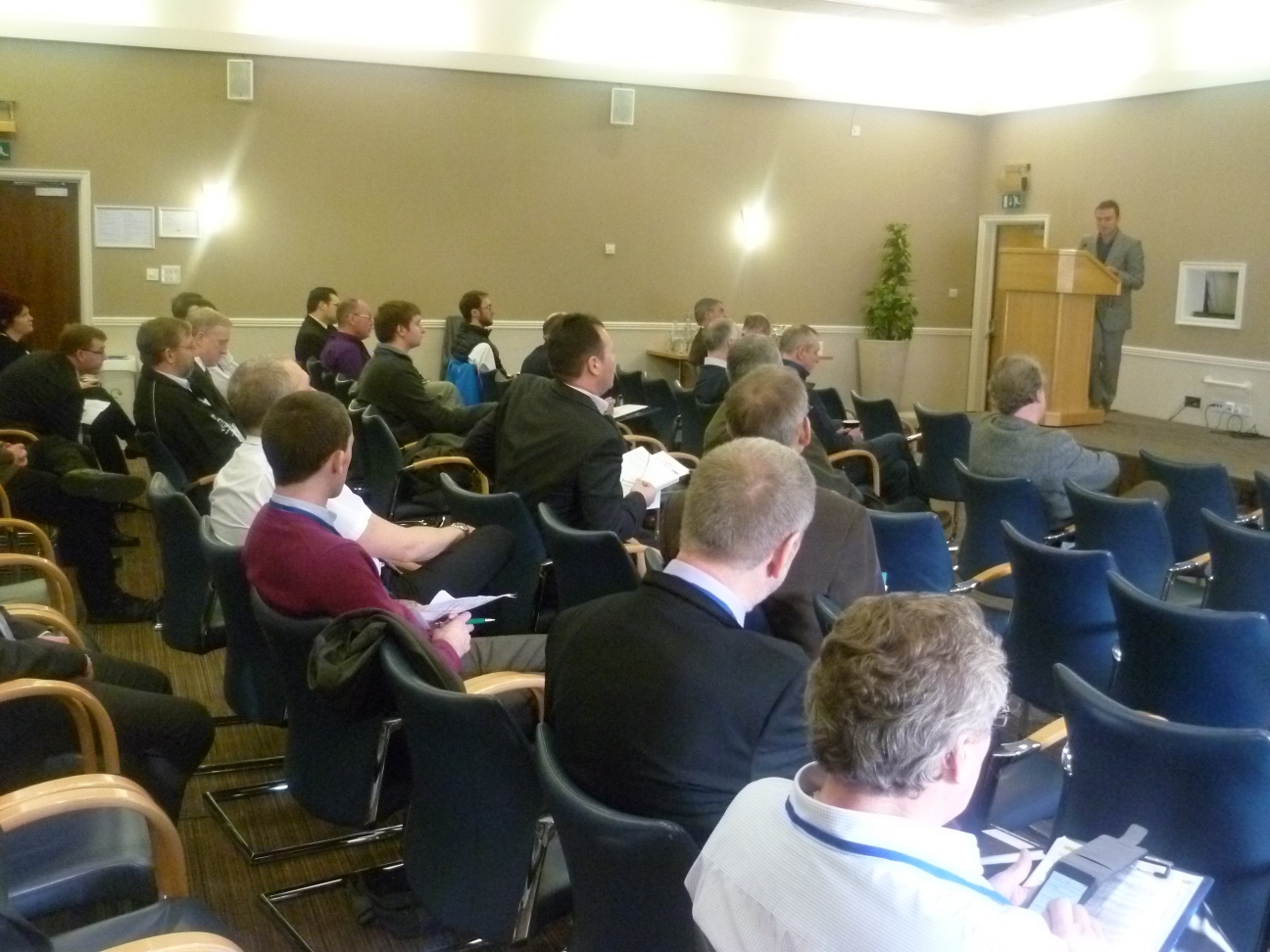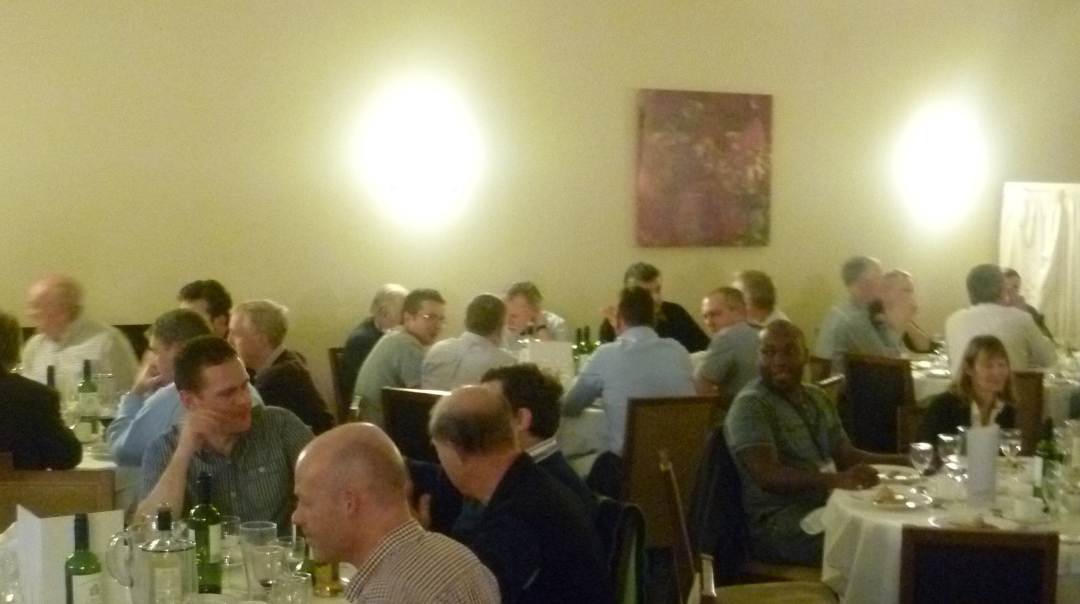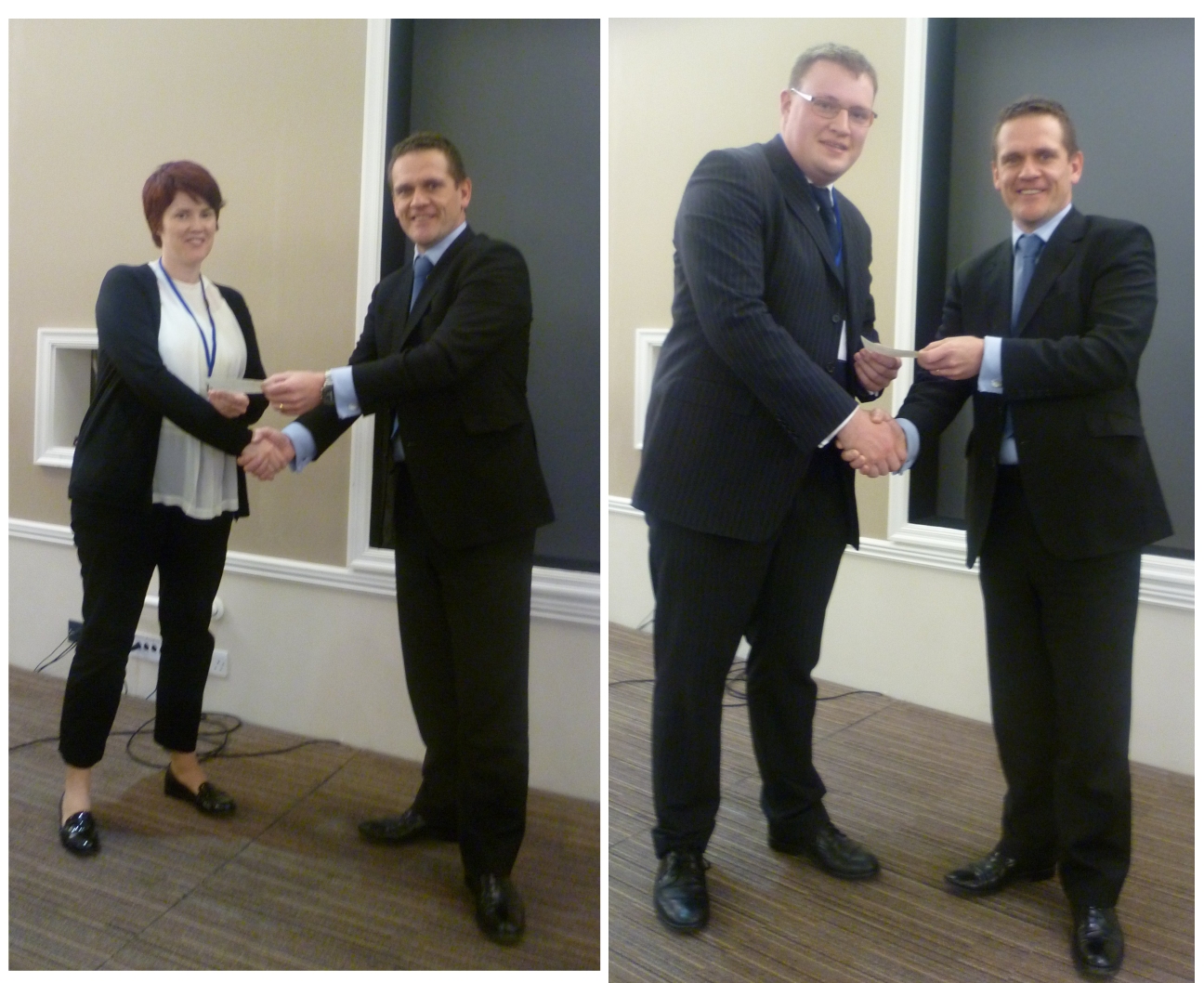The November 2013 meeting took place at Wyboston Lakes. Olive Murphy was the winner of the Steve Evans-Pughe prize for the best paper and William Otter was the runner-up. The prize is sponsored by AWR.
Young Engineer Sponsorship: The ARMMS RF & Microwave Society sponsorsed two young engineers (28 or below) to attend this meeting. The recipients were Jonathan Rawlinson and Tim Canning. Sponsorship is £100 cash plus free attendance (including conference dinner and overnight accommodation). .
For all enquiries please email enquiries@armms.org
 |  |  |
Wyboston Lakes
Great North Road
Wyboston
Bedfordshire
MK44 3AL
| Tel | 0333 7007 667 |
| sales@wybostonlakes.co.uk. | |
| Web | http://www.wybostonlakes.co.uk/ |
Stepan Lucyszyn
Imperial College, London
100GHz Photonic Crystal Devices | |
| William Otter | |
| Imperial College London | |
Within this paper we show the potential for high resistivity silicon photonic crystal devices at W-Band. This technology is usually associated with optical wavelengths but by scaling down in frequency we show through simulations and experimentally measured how simple waveguides can be realised which can then be used to create switches and attenuators through laser illumination of the waveguide. Furthermore we go on to show how this technology can give unprecedented Q-factor performance for millimetre wave resonators/filters that are suitable for monolithic integrated circuits.
| |
| 100GHz Photonic Crystal Devices | |
3D Smith charts | |
| Andrei Muller | |
| Telecom Institute Of Valencia | |
The paper presents the applications of the recently proposed 3D Smith chart by means of a completely updated 3D Smith chart tool issued in September 2013. It is capable to deal with both active and passive microwave circuit parameters simultaneously. The 3D Smith chart key maps all the active and passive loads on the surface of the unit ball (inverted Riemann sphere), so that circuits with negative resistance are now assembled in the South hemisphere, circuits with positive resistance (classical 2D Smith chart) are mapped into the north hemisphere, whereas inductive and capacitive circuits are placed at the East and West of Greenwich meridian, respectively. The updated 3D Smith chart tool can plot simultaneously and in an unique manner scattering parameters, power wave reflection coefficients, voltage reflection coefficients, input and output stability circles, and deal with real and also complex characteristic impedances ports. | |
| 3D Smith charts | |
A Guide to the Design of Laminate PCBs at Microwave Frequencies | |
| Liam Devlin and Graham Pearson | |
| Plextek RFI | |
Laminate PCB technology is now routinely used for the realisation of low cost subsystems operating at frequencies up to around 40GHz. The wide availability of microwave components in SMT compatible packages and low cost, high performance laminate PCB materials have made this possible. However, careful design and attention to detail is vital in order to avoid serious performance issues at microwave frequencies. This paper presents guidelines and useful tips for optimising the performance of SMT based laminate PCBs operating at microwave frequencies. Liam provides expert witness advice on MMICs and other microwave and mm-wave technologies. | |
| A Guide to the Design of Laminate PCBs at Microwave Frequencies | |
A Low Cost V-band Amplifier MMIC Covering 54 to 67GHz | |
| Liam Devlin, Graham Pearson and James Nelson | |
| Plextek RFI and TriQuint Semiconductor | |
This paper describes the design and measured performance of a low cost amplifier MMIC covering 54 to 67GHz. The IC is realised on a low cost GaAs PHEMT process produced on 6” diameter wafers with optically defined gates. The two stage design operates from a single +3V supply (44mA) with a gain of 11.5dB. The measured 1dB gain compressed output power level is +12dBm. The design includes self bias resistors to reduce performance variation with process and temperature. The paper includes details of the design approach, the simulated performance, including EM, and the RFOW measured performance.
| |
| A Low Cost V-band Amplifier MMIC Covering 54 to 67GHz | |
Amateur Radio Astronomy Imaging in the Ku Band | |
| Jonathan Rawlinson | |
| - | |
Experiments for creating solar images using amateur equipment in the Ku band (i.e. 12 to 18 GHz) are described in detail. Good results are reported that are obtained with relatively low cost commercial-of-the-shelf equipment. | |
| Amateur Radio Astronomy Imaging in the Ku Band | |
An Engineering Approach Towards Creating Ubiquitous THz Applications | |
| Stepan Lucyszyn | |
| Imperial College London | |
Within the wider terahertz (THz) frequency range (ca. 0.1 to 10 THz), the sub-millimetre wave frequency band (between 0.3 and 3 THz) is still considered to be a largely unexplored part of the electromagnetic spectrum. This ‘THz Gap’, between conventional electronics and photonics, offers the real potential for both scientific and commercial exploitation. However, while the majority of THz groups focus on the former, it is the latter that offers the key to bridge the THz Gap to ubiquitous applications. To this end, new engineering solutions are needed in modelling (mathematical & numerical), design (synthesis & analysis) and fabrications (precision & volume production). As ubiquitous THz applications emerge, the costs of associated passive components, active devices and metrology will fall, creating a positive spiral of growth in all areas; enhancing our modern day living and with the prospect of a huge societal and economic impact. This lecture will examine the various facets associated with adopting an engineering approach towards creating ubiquitous THz applications. More specifically, for the many engineers currently working at microwave and millimetre-wave frequencies (below ca. 100GHz), the challenges for working with shorter wavelengths and with more complicated carrier transport and molecular physics will be explained. The lecture will also give, by example, a unique perspective on THz engineering – with conventional approaches and new paradigm shifts – from nano structures, metamaterials and solid-state & vacuum electronics to complete systems level integration, ubiquitous applications and their impact. | |
| An Engineering Approach Towards Creating Ubiquitous THz Applications | |
Beyond RF Ablation. Other uses for RF within the body | |
| Olive Murphy | |
| Imperial College London | |
The opportunities for using RF within the body to monitor vital signs and assist in diagnosing chronic diseases are vast. Current RF technologies, in particular when used for high speed high data communications, are incredibly advanced. Applying just a fraction of this technology has enabled the continuous wireless monitoring of a deeply implanted blood pressure monitor – enabling access to previously unavailable clinical data and an array of benefits for patients and healthcare providers. While a relatively simple concept exasperated by the presence of the body – this project has always remained true to the fundamental principles of RF engineering. An overview of the use of RF will be presented along with the first known wireless pressure data from the left ventricle of the heart of a living swine. | |
| Beyond RF Ablation. Other uses for RF within the body | |
Clipping Contours: An RFPA Design Tool | |
| Tim Canning, Steve C. Cripps | |
| University of Cardiff | |
This paper presents the "clipping contour", a new RFPA design tool which enables the designer to visualise and control the possibly detrimental effects of the second harmonic impedance, maintaining power, linearity and efficiency in broadband RFPA designs. This new tool allows the designer to prevent the voltage waveform from crossing zero, thus clipping the current waveform and degrading performance. This simplifies the process of managing waveform interaction with the device knee region, and expands the continuous mode design space to incorporate non-zero second harmonic resistive matching. A design example is fabricated, demonstrating the utility of the second harmonic clipping contour tool as part of the PA design process. A 10W GaN demonstrator gives measured CW power >8.5W, drain efficiency >60%, and better than -30dB ACPR over a bandwidth of 1-2.9GHz. | |
| Clipping Contours: An RFPA Design Tool | |
Design of an Improved Performance Dual-band Power Divider | |
| Anastasios Papatsoris and Stelios Tsitsos | |
| Technical University of Serres | |
In this paper an improved performance dual-band power divider with respect to output return loss and port isolation is presented. The proposed circuit involves additional transmission lines and open-circuited stubs to achieve better output return loss and port isolation results. The design features a transmission line only structure (plus the isolation resistor) thus avoiding the parasitic effects of lumped components. Additionally it can be easily implemented since it employs realistic characteristic impedance values. Analytical expressions for the design equations are derived using the even and odd mode analysis and measured results verify the performance of the structure.
| |
| Design of an Improved Performance Dual-band Power Divider | |
GaN, an Enabling Technology for Enhanced Radar Performance | |
| C. Harris, R. Pengelly, S. Wood and T. Dekker | |
| Cree | |
GaN is now well established as a mainstream semiconductor material that provides many electrical and physical advantages over the traditional Si or GaAs technologies. In this paper we review some of the latest developments in this area and how the capabilities of this new material are enhancing the performance of new radar systems. | |
| GaN, an Enabling Technology for Enhanced Radar Performance | |
Liquid Detection by Microwave Resonators | |
| Norbert Klein | |
| EMISENS | |
It is well know that the direct observation of the complex dielectric permittivity of liquids at microwave frequency enables fingerprint detection of certain categories of liquids, such as aqueous, organic and corrosive. Over the past seven years, we have been working on ultrafast detection of liquid explosives in sealed containers based on the evanescent field of a patented multimode cavity. Our research has led to the development of a bottle scanner for airport checkpoints, which has achieved the certification for use in European airports and passed a large number of field trials in airports worldwide. In this contribution the technology of evanescent field liquid sensing and its implementation into a user friendly software and hardware interface are explained. Moreover, orthogonal sensor approaches and verification schemes aiming to reduce false alarms will be discussed. As an object of current research within Imperial College, the use of microwave resonators for biosensors will be explained. As an example of a promising spin-off from this research, a possible haemoglobin sensor for microliter blood analysis, will be presented. | |
| Liquid Detection by Microwave Resonators | |
PCB Breakouts for Small Form-Factor RF Circuits | |
| Tony McDonald | |
| Chemring Technology Solutions | |
This paper describes the application of a PCB manufacturing technique to produce very small RF circuits, which are easily testable deployable and programmable. Design rules for successful replication of the technique are given. The RF performance of an example PCB manufactured using this technique is quantified.
| |
| PCB Breakouts for Small Form-Factor RF Circuits | |
Recent developments in High Power SSPAs - A European Perspective | |
| Dominic FitzPatrick | |
| PoweRFul Microwave | |
This presentation will review the most recent developments in solid state power amplifiers in Europe from both a power and a frequency perspective, at device, module and system level. It will attempt to establish the current baseline and the drivers behind and enabling technologies of future systems. | |
| Recent developments in High Power SSPAs - A European Perspective | |
Renewable Energy Ad-hoc Communication Hub (REACH) | |
| K. Tong, A. Al-armaghany, A. Amin and S. Halai | |
| University College London | |
Many people in developing countries cannot enjoy the benefit brought by mobile communication, such as education, e-health, medical treatment and disaster warning etc. Because of the poor power supply network infrastructure, mobile coverage in developing countries cannot keep up with the fast growth of mobile phone users, for example in Africa, the average network coverage is only 15%. It is predicted that mobile coverage there will only expand slowly, as the conventional electricity-hungry mobile base stations need the power grid to operate. This will increase the emissions of carbon dioxide and other toxic pollutant. REARCH is an immediate and clean solution to address this problem. With its green power source and embedded antenna system design, it can be efficiently deployed to form its co-operative ad-hoc mobile networks for expanding the coverage in areas far away from the national power grids. Therefore people living in remote or off-power-grid areas could access mobile network connections for the first time. The key technology of REARCH is the novel embedded high performance antenna systems that can amplify and relay the mobile phone signal to the users in the remote areas. There are reception blind spots, power/range problems in the existing base station scenario in developing countries; we cannot simply increase the output power to cover the blind spots and extend the range. An alternative smart way to solve the problem is to use a combination of high-gain, may be beamforming, antenna and high-efficiency signal repeater to collect radio waves from the nearby mobile phone base stations. Then the amplified signal can either transmit to other stations for even longer range communication through the ad-hoc network technology, or create a signal shower through the omni-directional antenna serving the people around the stations. REARCH’s embedded design enables easy deployment of the station in different geographical environments. In addition, the renewable energy source, for example flexible solar panels mounted on the foldable top of the stations, will generate electricity without connecting to any power plants. The generated electricity will power the antenna system and charge up the high-capacity reserve batteries. It also has a recharge socket for mobile phones or other mobile devices. This innovation will significantly reduce the discharge of carbon dioxide and other toxic pollutant. Moreover REARCH will work particularly well initially in African and Middle Eastern countries, because many people there live in small remote and separated villages located around different part of the countries. It is not cost effective to setup a dedicated mobile base station and the required power grid to serve a small community. The three functional prototypes have proven to be a success, and we will utilise the know-how gained for the large-scale deployment of the concept and technology. | |
| Renewable Energy Ad-hoc Communication Hub (REACH) | |
Any companies booking two or more delegate places are able to take part in the commercial exhibition that accompanies the conference. If you are interested in exhibiting at future meetings please email exhibition@armms.org to reserve space.
The sponsor for this meeting is INTERLLIGENT RF & Microwave Solutions, which launched INTERLLIGENT UK in 2014 to provide RF test equipment rental in the UK
Contributions are invited with an emphasis on RF and microwave design, research, testing and associated subjects. An oral presentation will be made at the meeting and a written paper will be required for publication in the society digest, which is distributed to delegates at the meeting. Prospective speakers are requested to submit a title and a short abstract to the technical coordinator (see above) as soon as possible.
Click here to view our Guidelines for Authors
Click here to view our Publication Release Form